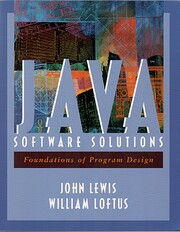

Cliquer sur une vignette pour aller sur Google Books.
|
Chargement... Java software solutions : foundations of program designpar John Lewis, Willian Loftus
 Aucun Actuellement, il n'y a pas de discussions au sujet de ce livre. This is a great book for anyone who wants to learn about computer programming and also learn about programming in Java. I have read many books on programming, and own quite a few, but this one is really great. Starts out with the easy material and then gets into the more difficult material. Has great code that actually works. A great buy or book to check out from your library. aucune critique | ajouter une critique
This best-selling text by Lewis and Loftus provides an introduction to both the Java programming language and the techniques for writing high-quality programs. This book provides an object-oriented approach that naturally progresses in a way that beginning programmers easily understand by first using objects, then writing clases. The book is also known for providing an introduction to programming practices that leads to well-designed software solutions. The use of graphical user interfaces and event processing is covered in optional, self-contained Graphics Track sections at the end of each chapter.This book also comes with Addison-Wesley's CodeMate. This online program competency builder transforms a student's reading experience into a dynamic programming environment with a click of a mouse. CodeMate allows students to view, compile, run, and edit programming problems directly from the textbook without installing a compiler. Aucune description trouvée dans une bibliothèque |
Discussion en coursAucunCouvertures populaires
 Google Books — Chargement... Google Books — Chargement...GenresClassification décimale de Melvil (CDD)005.133Information Computing and Information Computer programming, programs, data, security Programming Languages General Programming LanguagesClassification de la Bibliothèque du CongrèsÉvaluationMoyenne: (3.25) (3.25)
Est-ce vous ?Devenez un(e) auteur LibraryThing. |
||||||||||||||||||||||||||||||||||||||||||||||||||||||||||||||||||||||||||||||||||||||||||||||||||||||||||||||||||||||||
Ikke helt tosset bog om Java. Det her er førsteudgaven og den er senere kommet i en hel del reviderede udgaver. (